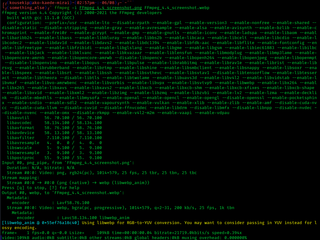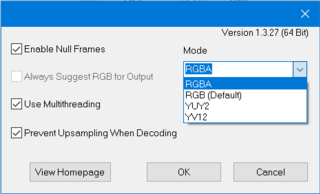In information theory, data compression, source coding, or bit-rate reduction is the process of encoding information using fewer bits than the original representation. Any particular compression is either lossy or lossless. Lossless compression reduces bits by identifying and eliminating statistical redundancy. No information is lost in lossless compression. Lossy compression reduces bits by removing unnecessary or less important information. Typically, a device that performs data compression is referred to as an encoder, and one that performs the reversal of the process (decompression) as a decoder.
Lossless compression is a class of data compression that allows the original data to be perfectly reconstructed from the compressed data with no loss of information. Lossless compression is possible because most real-world data exhibits statistical redundancy. By contrast, lossy compression permits reconstruction only of an approximation of the original data, though usually with greatly improved compression rates.

A video codec is software or hardware that compresses and decompresses digital video. In the context of video compression, codec is a portmanteau of encoder and decoder, while a device that only compresses is typically called an encoder, and one that only decompresses is a decoder.

FFmpeg is a free and open-source software project consisting of a suite of libraries and programs for handling video, audio, and other multimedia files and streams. At its core is the command-line ffmpeg tool itself, designed for processing of video and audio files. It is widely used for format transcoding, basic editing, video scaling, video post-production effects and standards compliance.
WavPack is a free and open-source lossless audio compression format and application implementing the format. It is unique in the way that it supports hybrid audio compression alongside normal compression which is similar to how FLAC works. It also supports compressing a wide variety of lossless formats, including various variants of PCM and also DSD as used in SACDs, together with its support for surround audio.
QuickTime Animation format is a video compression format and codec created by Apple Computer to enable playback of RGB video in real time without expensive hardware. It is generally found in the QuickTime container with the FourCC 'rle '. It can perform either lossless or lossy compression and is one of the few video codecs that supports an alpha channel. Supported color depths are 1-bit (monochrome), 15-bit RGB, 24-bit RGB, 32-bit ARGB, as well as palettized RGB. As a result of reverse-engineering of the format, a decoder is implemented in XAnim as well as an encoder and decoder in libavcodec.

Lagarith is an open source lossless video codec written by Ben Greenwood. It is a fork of the code of HuffYUV and offers better compression at the cost of greatly reduced speed on uniprocessor systems. Lagarith was designed and written with a few aims in mind:
Microsoft Video 1 or MS-CRAM is an early lossy video compression and decompression algorithm (codec) that was released with version 1.0 of Microsoft's Video for Windows in November 1992. It is based on MotiVE, a vector quantization codec which Microsoft licensed from Media Vision. In 1993, Media Vision marketed the Pro Movie Spectrum, an ISA board that captured video in both raw and MSV1 formats.
Α video codec is software or a device that provides encoding and decoding for digital video, and which may or may not include the use of video compression and/or decompression. Most codecs are typically implementations of video coding formats.
MPEG-4 Audio Lossless Coding, also known as MPEG-4 ALS, is an extension to the MPEG-4 Part 3 audio standard to allow lossless audio compression. The extension was finalized in December 2005 and published as ISO/IEC 14496-3:2005/Amd 2:2006 in 2006. The latest description of MPEG-4 ALS was published as subpart 11 of the MPEG-4 Audio standard in December 2019.
JPEG XR is an image compression standard for continuous tone photographic images, based on the HD Photo specifications that Microsoft originally developed and patented. It supports both lossy and lossless compression, and is the preferred image format for Ecma-388 Open XML Paper Specification documents.
Asao is a proprietary single-channel (mono) codec and compression format optimized for low-bitrate transmission of audio, developed by Nellymoser Inc.

WebP is a raster graphics file format developed by Google intended as a replacement for JPEG, PNG, and GIF file formats. It supports both lossy and lossless compression, as well as animation and alpha transparency.

x265 is an encoder for creating digital video streams in the High Efficiency Video Coding (HEVC/H.265) video compression format developed by the Joint Collaborative Team on Video Coding (JCT-VC). It is available as a command-line app or a software library, under the terms of GNU General Public License (GPL) version 2 or later; however, customers may request a commercial license.
Sorenson Media was an American software company specializing in video encoding technology. Established in December 1995 as Sorenson Vision, the company developed technology which was licensed and ultimately acquired from Utah State University. The company first announced its codec at a developer’s preview at MacWorld Expo in January 1997.
Apple Video is a lossy video compression and decompression algorithm (codec) developed by Apple Inc. and first released as part of QuickTime 1.0 in 1991. The codec is also known as QuickTime Video, by its FourCC RPZA and the name Road Pizza. When used in the AVI container, the FourCC AZPR is also used.
QuickTime Graphics is a lossy video compression and decompression algorithm (codec) developed by Apple Inc. and first released as part of QuickTime 1.x in the early 1990s. The codec is also known by the name Apple Graphics and its FourCC SMC. The codec operates on 8-bit palettized RGB data. The bit-stream format of QuickTime Graphics has been reverse-engineered and a decoder has been implemented in the projects XAnim and libavcodec.
UT Video Codec Suite is a fast, lossless video codec, developed by Takeshi Umezawa and released under the free GNU General Public License. The algorithm of UT video is based on the Huffman code.





